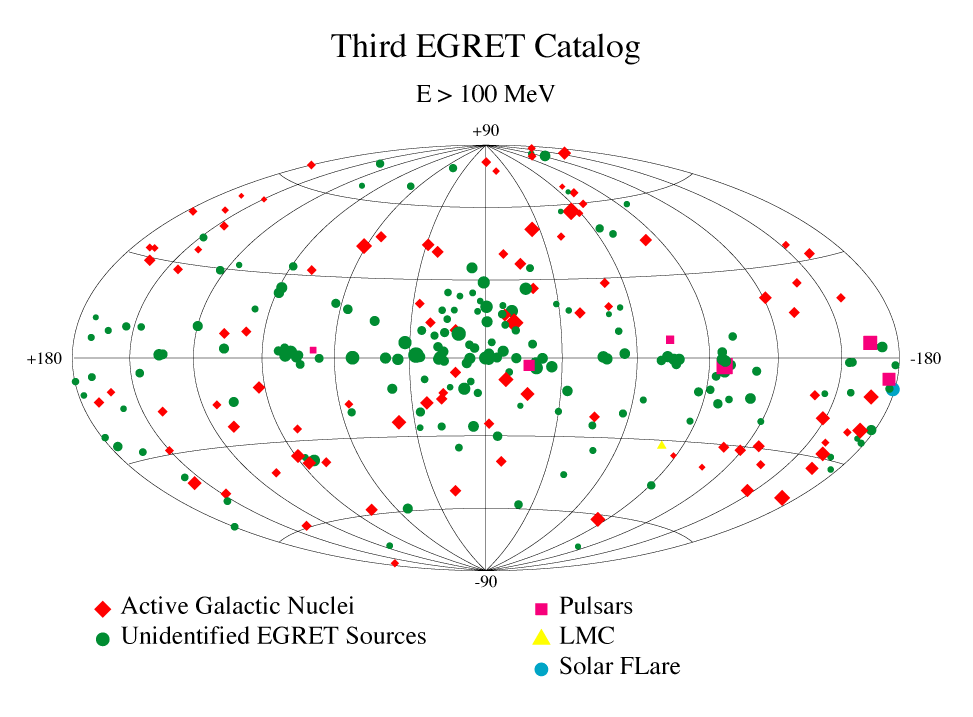Third EGRET Catalog
A Press Release by Chris Wanjek
Click image for larger view
This Third EGRET Catalog, presented today at the 193rd American Astronomical Society Meeting in Austin, Texas, contains 271 gamma-ray sources detected from 1991-1995, including the Large Magellanic Cloud, the great solar flare of 1991, a probable radio galaxy, and 170 sources yet unidentified.
"This catalog includes all the high-energy gamma ray sources in the Universe that could be detected by EGRET," said Dr. Robert Hartman, an astrophysicist on the EGRET team at NASA's Goddard Space Flight Center. "This is a huge step for gamma-ray astronomy from the early days 25 years ago, yet in many ways the field is still in its infancy."
Dr. Hartman said that NASA's Gamma-Ray Large Area Space Telescope (GLAST), planned for a 2005 launch date, is expected to detect thousands of high-energy gamma ray sources with a 30% increase in sensitivity.
According to Dr. Neil Gehrels, the Gamma Ray and Cosmic Ray Astrophysics Branch Head at Goddard, "Gamma-ray astronomy is a window into the Universe's hottest and most cataclysmic events, and I am tremendously excited by the EGRET catalog. The field of gamma-ray astrophysics is becoming a real astronomical discipline with a significant number of objects to observe."
High-energy gamma rays are largely produced by high-speed particle collisions. Particles from a supernova explosion, for example, can accelerate to nearly the speed of light and collide with gas in the interstellar medium. We observe this interaction as gamma rays. The galactic plane, in fact, glows in gamma ray energy from high speed collisions.
EGRET covers a very wide chunk of gamma ray energies in the electromagnetic spectrum, from 30 to 20,000 MeV, which is comparable to a single telescope measuring from infrared, through ultraviolet and into X-ray wavelengths.
Because of a low photon detection rate, EGRET produces likelihood maps, not visual images. These maps depict the likelihood within a 50%, 68%, 95% and 99% probability that a gamma-ray source is at a particular point in the sky. Those sources detected at less than a certain degree of statistical probability, depending on its location relative to the galactic plane, are not included in the Third EGRET catalog. This threshold eliminated a few sources originally included in the Second EGRET catalog.
Also not included in this Third EGRET Catalog were gamma ray bursts -- brief, intense flashes of gamma rays which are thought to be the most powerful forces in the Universe other than the Big Bang. The Catalog focuses instead on permanent sources of gamma rays.
This will most likely be the last full EGRET catalog, said Dr. Hartman, for the instrument will now concentrate on narrower regions of observations and conserve its remaining neon gas supply.
EGRET was assembled at NASA's Goddard Space Flight Center by a team of scientists from Goddard, Stanford University, the Max-Planck Institute for Extraterrestrial Physics, and Grumman Corporation (now part of Northrup-Grumman). EGRET is one of the four gamma-ray instruments on the Compton Gamma Ray Observatory, the second of NASA's Great Observatories and the gamma-ray equivalent to the Hubble Space Telescope. Compton was launched aboard the Space Shuttle Atlantis in April, 1991, and at 17 tons, it is the largest astrophysical payload ever flown.
The Third EGRET Catalog will be published in an upcoming issue of Astrophysical Journal Supplements.
Obtain a copy of the Third EGRET Catalog.
If you have a question about CGRO, please contact us via the Feedback form.

